Dimethyl carbamoyl chloride
Agent Name
Dimethyl carbamoyl chloride
CAS Number
79-44-7
Formula
C3-H6-Cl-N-O
Major Category
Toxic Gases & Vapors

Synonyms
(Dimethylamino)carbonyl chloride; Carbamic chloride, dimethyl-; Carbamoyl chloride, dimethyl-; Carbamyl chloride, N,N-dimethyl-; Chlorid kyseliny dimethylkarbaminove [Czech]; Chloroformic acid dimethylamide; Dimethyl carbamoyl chloride; Dimethylamid kyseliny chlormravenci [Czech]; Dimethylcarbamic acid chloride; Dimethylcarbamic chloride; Dimethylcarbamidoyl chloride; Dimethylcarbamoyl chloride; Dimethylcarbamyl chloride; Dimethylchloroformamide; Dimethylkarbamoylchlorid [Czech]; N,N-Dimethylcarbamic acid chloride; N,N-Dimethylcarbamidoyl chloride; N,N-Dimethylcarbamoyl chloride; N,N-Dimethylcarbamyl chloride; TL 389v; [ChemIDplus] DMCC; {ACGIH] UN2262
Category
Acid Halides
Description
Clear, colorless liquid; [NIOSH] Noxious odor; [ACGIH]
Sources/Uses
Used to manufacture carbamate pesticides, dyes, and drugs; Exposed workers include "pesticide formulators, dye makers, and pharmaceutical workers." [ACGIH]
Comments
Liquid causes second or third degree burns after short contact. [CHRIS] A lachrymator; Inhalation exposure to HCl may cause chemical pneumonitis; [HSDB] DMCC reacts with tissue at the point of contact. DMCC hydrolyzes to dimethylamine, CO2, and HCl. Animals in feeding studies develop liver hemorrhages. “Sprague-Dawley rats were exposed by inhalation 6 hours/day, 5 days/week for 6 weeks at 0.5, 1.0, or 2.0 ppm DMCC in an exposure chamber and held without further exposure for up to 2 years. A dose-response relationship for both the development of morphological lesions and for tumor incidences of the nasal cavity and nasopharyngeal areas was seen, ranging from 89% tumor incidence at 2 ppm to 4% incidence at 0.5 ppm. No tumors in these regions were reported in the controls.” [ACGIH]
Biomedical References
Exposure Assessment
Skin Designation (ACGIH)
Yes
TLV (ACGIH)
0.005 ppm
Vapor Pressure
1.95 mm Hg
Lethal Concentration
LC50 (rat) = 180 ppm/ 6h
Explanatory Notes
Flash point: not available; [ACGIH] VP from HSDB;
Adverse Effects
Lachrymator
Yes
Toxic Pneumonitis
Yes
Hepatotoxin
Hepatoxic (a) from occupational exposure (secondary effect) or (b) in animal studies or in humans after ingestion
Dermatotoxin
Skin burns
IARC Carcinogen
Probable (2a)
NTP Carcinogen
Anticipated human carcinogen
ACGIH Carcinogen
Suspected Human
Diseases, Processes, and Activities Linked to This Agent
Other Information
No other related information on this agent was found.